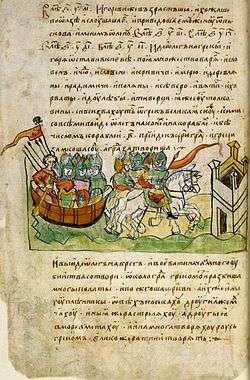Primary Chronicle

The Tale of Past Years (Old East Slavic: Повѣсть времѧньныхъ лѣтъ, Pověstĭ Vremęnĭnyhŭ Lětŭ, Russian: Повесть временных лет, Povest’ vremennyh let) or Primary Chronicle is a history of Kievan Rus' from about 850 to 1110, originally compiled in Kiev about 1113. The work is considered to be a fundamental source in the interpretation of the history of the Eastern Slavs.
Three editions
First
Tradition long regarded the original compilation as the work of a monk named Nestor (c. 1056 – c. 1114); hence scholars spoke of Nestor's Chronicle or of Nestor's manuscript. His compilation has not survived. Nestor's many sources included earlier (now-lost) Slavonic chronicles, the Byzantine annals of John Malalas and of George Hamartolus, native legends and Norse sagas, several Greek religious texts, Rus'–Byzantine treaties, and oral accounts of Yan Vyshatich and of other military leaders. Nestor worked at the court of Sviatopolk II of Kiev (ruled 1093–1113) and probably shared Sviatopolk's pro-Scandinavian policies.
The early part of the Chronicle features many anecdotal stories, among them those of the arrival of the three Varangian brothers, the founding of Kiev, the murder of Askold and Dir (ca. 882), the death (912) of Oleg (fatally bitten by a serpent concealed in the skeleton of his horse), and the vengeance taken by Olga, the wife of Igor, on the Drevlians, who had murdered her husband. The account of the labors of Saints Cyril and Methodius among the Slavic peoples also makes a very interesting tale, and to Nestor we owe the story of the summary way in which Vladimir the Great (rules 980 to 1015) suppressed the worship of Perun and other traditional gods at Kiev.
Second
In the year 1116, Nestor's text was extensively edited by the hegumen Sylvester who appended his name at the end of the chronicle. As Vladimir Monomakh was the patron of the village of Vydubychi where his monastery is situated, the new edition glorified that prince and made him the central figure of later narrative. This second version of Nestor's work is preserved in the Laurentian codex (see below).
Third
A third edition followed two years later and centered on the person of Vladimir's son and heir, Mstislav the Great. The author of this revision could have been Greek, for he corrected and updated much data on Byzantine affairs. This latest revision of Nestor's work is preserved in the Hypatian codex (see below).
Two manuscripts
Because the original of the chronicle as well as the earliest known copies are lost, it is difficult to establish the original content of the chronicle. The two main sources for the chronicle's text as it is known presently are the Laurentian Codex and the Hypatian Codex.
The Laurentian Codex was compiled in what are today Russian lands by the Nizhegorod monk Laurentius for the Prince Dmitry Konstantinovich in 1377. The original text he used was a lost codex compiled for the Grand Duke Mikhail of Tver in 1305. The account continues until 1305, but the years 898–922, 1263–83 and 1288–94 are missing for reasons unknown. The manuscript was acquired by the famous Count Musin-Pushkin in 1792 and subsequently presented to the National Library of Russia in Saint Petersburg.
The Hypatian Codex dates to the 15th century. It was written in what are today Ukrainian lands and incorporates much information from the lost 12th-century Kievan and 13th-century Halychian chronicles. The language of this work is the East Slavic version of Church Slavonic language with many additional irregular east-slavisms (like other east-Slavic codices of the time). Whereas the Laurentian (Muscovite) text traces the Kievan legacy through to the Muscovite princes, the Hypatian text traces the Kievan legacy through the rulers of the Halych principality.The Hypatian codex was rediscovered in Kiev in the 1620s and copy was made for Prince Kostiantyn Ostrozhsky. A copy was found in Russia in the 18th century at the Ipatiev Monastery of Kostroma by the Russian historian Nikolai Karamzin.
Numerous monographs and published versions of the chronicle have been made, the earliest known being in 1767. Aleksey Shakhmatov published a pioneering textological analysis of the narrative in 1908. Dmitry Likhachev and other Soviet scholars partly revisited his findings. Their versions attempted to reconstruct the pre-Nestorian chronicle, compiled at the court of Yaroslav the Wise in the mid-11th century.
Assessment
Unlike many other medieval chronicles written by European monks, the Tale of Bygone Years is unique as the only written testimony on the earliest history of East Slavic people. Its comprehensive account of the history of Rus' is unmatched in other sources, although important correctives are provided by the Novgorod First Chronicle. It is also valuable as a prime example of the Old East Slavonic literature.
See also
- Academic Chronicle
- Freising manuscripts
- Ioachim Chronicle
- Nestor the Chronicler
- Russkaya Pravda
- Izbornyk
Further reading
- Chadwick, Nora Kershaw (1946). The Beginnings of Russian History: An Enquiry into Sources. Cambridge University Press. ISBN 0-404-14651-1.
- Velychenko, Stephen (1992). National history as cultural process: A survey of the interpretations of Ukraine's past in Polish, Russian, and Ukrainian historical writing from the earliest times to 1914. Edmonton. ISBN 0-920862-75-6.
- Velychenko, Stephen (2007). "Nationalizing and Denationalizing the Past. Ukraine and Russia in Comparative Context". Ab Imperio (1).
External links
- Transcription of the original text
- From the Laurentian manuscript
- From the Hypatian manuscript
- From the Novgorodian manuscript
- A collation of the chronicle by Donald Ostrowski in Cyrillic is available at http://hudce7.harvard.edu/~ostrowski/pvl/ together with an erudite and lengthy introduction in English. This is an interlinear collation including the five main manuscript witnesses, as well as a new paradosis, or reconstruction of the original.
- English translations
- The Russian Primary Chronicle, Laurentian Text. Translated and edited by Samuel Hazzard Cross and Olgerd P. Sherbowitz-Wetzor. Cambridge, MA: The Mediaeval Academy of America, 1953.
- Excerpts of Primary Chronicle, including founding of Novgorod by Rus, Attacks on Byzantines, and Conversion of Vladimir. Also mentions several Slavic tribes by name.